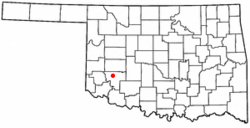Hobart, Oklahoma facts for kids
Quick facts for kids
Hobart, Oklahoma
|
|
|---|---|

Main Street of Hobart, 2004
|
|
| Motto(s):
"Hobart is not just a town, It's a Community."
|
|

Location of Hobart, Oklahoma
|
|
| Country | United States |
| State | Oklahoma |
| County | Kiowa |
| Area | |
| • Total | 3.36 sq mi (8.71 km2) |
| • Land | 3.36 sq mi (8.71 km2) |
| • Water | 0.00 sq mi (0.00 km2) |
| Elevation | 1,542 ft (470 m) |
| Population
(2020)
|
|
| • Total | 3,413 |
| • Density | 1,015.17/sq mi (391.91/km2) |
| Time zone | UTC-6 (Central (CST)) |
| • Summer (DST) | UTC-5 (CDT) |
| ZIP code |
73651
|
| Area code(s) | 580 |
| FIPS code | 40-35000 |
| GNIS feature ID | 2410770 |
Hobart is a city in Oklahoma, USA. It's also the main town, or county seat, of Kiowa County. It's located southwest of Oklahoma City and northwest of Lawton.
The city was named after Garret Hobart, who was the 24th Vice President of the United States. In 2020, about 3,413 people lived there. Hobart has its own airport, Hobart Regional Airport. You can also visit two museums in the city: the General Tommy Franks Museum and the Kiowa County Museum.
Contents
History of Hobart: From Tents to Town
The city of Hobart started very quickly on August 6, 1901. This was when land lots were sold on what used to be the Kiowa-Apache-Comanche Reservation in southern Oklahoma. Almost overnight, 2,936 people moved there, mostly living in tents. Because of all the tents, the town was first called "Ragtown."
Wooden buildings soon replaced the tents. By 1903, Hobart had electric lights and a factory that made ice. It also had big businesses that sold goods to other stores. The town's economy mainly grew from growing cotton. When Oklahoma became a state in November 1907, Hobart had 3,136 people.
Hobart's population went down a bit in 1920 but then grew again. In 1930, there were 4,982 people. The population reached its highest point in 1950 with 5,380 residents. After that, the number of people living in Hobart slowly started to decrease. In the 1950s, the town got a better water supply from new reservoirs. Hobart is connected by a water channel to Lake Hobart, which is a few kilometers north.
Geography of Hobart: Where It Is Located
Hobart is about 120 miles (193 km) southwest of Oklahoma City. It is also about 65 miles (105 km) northwest of Lawton.
The city covers a total area of 2.7 square miles (7.0 km²), and all of it is land.
Economy: How People Make a Living in Hobart
The area around Hobart first made money from farming. The main crops grown were wheat and cotton. Later, raising cattle also became very important. Today, Hobart is still mostly a farming town.
In the 21st century, most people in Hobart work in education, health care, and social services.
Population Changes in Hobart
Hobart's population has changed over the years:
| Historical population | |||
|---|---|---|---|
| Census | Pop. | %± | |
| 1910 | 3,845 | — | |
| 1920 | 2,936 | −23.6% | |
| 1930 | 4,982 | 69.7% | |
| 1940 | 5,380 | 8.0% | |
| 1950 | 5,132 | −4.6% | |
| 1960 | 5,132 | 0.0% | |
| 1970 | 4,638 | −9.6% | |
| 1980 | 4,735 | 2.1% | |
| 1990 | 4,305 | −9.1% | |
| 2000 | 3,997 | −7.2% | |
| 2010 | 3,756 | −6.0% | |
| 2020 | 3,413 | −9.1% | |
| U.S. Decennial Census | |||
In 2000, there were 3,997 people living in Hobart. About 29.3% of homes had children under 18. The average age in the city was 39 years old.
Historical Sites: Places to See
Five important historical places in Kiowa County are located in Hobart. These sites are listed on the National Register of Historic Places:
- Downtown Hobart Historic District: This area includes several historic buildings.
- Hobart City Hall: The city's government building.
- Kiowa County Courthouse: The main court building for the county.
- Hobart Public Library: A historic library building.
- Hobart Rock Island Depot: An old train station.
Media: News and Radio
Hobart has local radio stations and a newspaper.
Radio Stations
- 105.9 MHz: KQTZ (100 kW)
You can also hear these radio stations from farther away:
- 93.5 MHz: KPRO (45 kW)
- 106.9 MHz: KTJI (100 kW)
- 103.5 MHz: KVSP (100 kW)
Newspaper
The Hobart Democrat-Chief is the oldest business in Hobart. It started on August 1, 1901, and is still running today. Hobart also used to have two other newspapers: the Hobart Daily Chief and the Hobart Republican.
Notable People from Hobart
Many interesting people were born or raised in Hobart:
- Catharine Crozier: A famous organist, born in Hobart in 1914.
- Jeanetta Calhoun Mish: An Oklahoma Poet Laureate, born in Hobart.
- Alfred P. Slaner: A textile executive who grew up in Hobart.
- James Barnes (composer): A composer and tubist, born in Hobart in 1949.
Nearby Towns and Cities
 |
New Cordell, Oklahoma |  |
||
| Mangum, Oklahoma | Anadarko, Oklahoma | |||
| Altus, Oklahoma | Frederick, Oklahoma | Lawton, Oklahoma |
Images for kids
See also
 In Spanish: Hobart (Oklahoma) para niños
In Spanish: Hobart (Oklahoma) para niños



